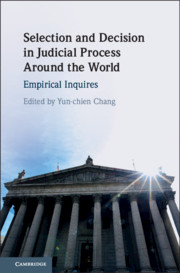Book contents
- Selection and Decision in Judicial Process around the World
- Selection and Decision in Judicial Process around the World
- Copyright page
- Dedication
- Contents
- List of Figures
- List of Tables
- List of Contributors
- Acknowledgments
- Introduction
- 1 Do Patent Law Suits Target Invalid Patents?
- 2 Platform Procedure
- 3 Speedy Adjudication in Hard Cases and Low Settlement Rates in Easy Cases
- 4 How Lower Courts Respond to a Change in a Legal Rule
- 5 Career Judge System and Court Decision Biases
- 6 Judges Avoid Ex Post but Not Ex Ante Inefficiency
- 7 When Winning Is Not Enough
- 8 The Evolution of Case Influence in Modern Consumer Standard Form Contracts
- 9 Judging Insurance Antidiscrimination Law
- 10 Are Judges Harsher with Repeat Offenders?
- 11 Does Efficiency Trump Legality?
- Index
- References
1 - Do Patent Law Suits Target Invalid Patents?
Published online by Cambridge University Press: 04 December 2019
- Selection and Decision in Judicial Process around the World
- Selection and Decision in Judicial Process around the World
- Copyright page
- Dedication
- Contents
- List of Figures
- List of Tables
- List of Contributors
- Acknowledgments
- Introduction
- 1 Do Patent Law Suits Target Invalid Patents?
- 2 Platform Procedure
- 3 Speedy Adjudication in Hard Cases and Low Settlement Rates in Easy Cases
- 4 How Lower Courts Respond to a Change in a Legal Rule
- 5 Career Judge System and Court Decision Biases
- 6 Judges Avoid Ex Post but Not Ex Ante Inefficiency
- 7 When Winning Is Not Enough
- 8 The Evolution of Case Influence in Modern Consumer Standard Form Contracts
- 9 Judging Insurance Antidiscrimination Law
- 10 Are Judges Harsher with Repeat Offenders?
- 11 Does Efficiency Trump Legality?
- Index
- References
Summary
One objective of the patent litigation system is to screen meritorious from non-meritorious patents and invalidate the latter. While much of this screening may occur at trial, some amount of targeting may take place at the time of the filing of the suit itself. In this chapter, we assess the targeting efficiency of the patent litigation system at this earlier filing stage. Should the system indeed screen at this stage, one would predict a higher likelihood of patent lawsuits among a set of patents with weaker underlying validity relative to a set of patents with stronger underlying validity. In prior work (Frakes and Wasserman, Review of Economics and Statistics, 2017), we found that as examiners were given less time to review applications, they granted patents at higher rates, with the resulting marginal patents exhibiting greater markers of invalidity and attracting more litigation. An implication of these findings is that patents with more questionable validity—due to the leniency of the examiner—are indeed more likely to wind up in litigation, a finding supportive of filing-stage screening of meritorious claims. Our analysis in this book chapter attempts to generalize these prior findings to sources of examiner leniency beyond time constraints. More broadly, we characterize an examiner’s leniency by their overall grant rate, taking advantage of the fact that applications are effectively randomized across examiners. Consistent with our prior findings, we find that lenient examiners are more likely, on average, to issue patents with markers suggestive of weaker underlying validity and that are more likely to attract litigation. Ultimately, our findings suggest that legally invalid patents issued by the U.S. Patent Office are substantially more likely to be the target of litigation relative to legally valid patents.
Keywords
- Type
- Chapter
- Information
- Selection and Decision in Judicial Process around the WorldEmpirical Inquires, pp. 6 - 29Publisher: Cambridge University PressPrint publication year: 2019
References
- 3
- Cited by

